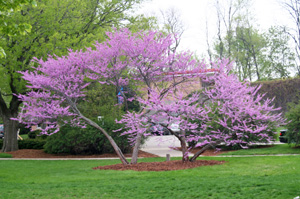
Cercis canadensis is a small tree or large shrub native to eastern North America. Its native range extends from southern Iowa to Pennsylvania, south to northern Florida, and west into Texas where it is an understory tree in mixed forests especially on rich bottom lands. Although it hails from
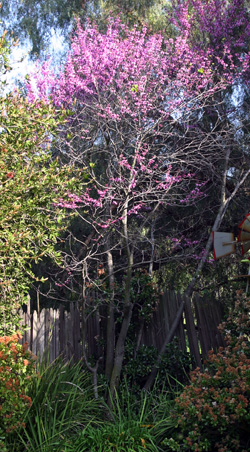
south of Wisconsin, many northern strains of this plant have been growing in the southern half of the state for decades (from along a diagonal line from La Crosse to just north of Green Bay). Commonly called eastern redbud, this deciduous tree in the legume family (Fabaceae) is commonly used as an ornamental in gardens and landscaping in zones 4 to 9. Eastern redbud is the state tree of Oklahoma. There are two varieties of this species with smaller, glossier leaves and often a more compact form that occur in Texas and Mexico, as well as the related western redbud, C. occidentalis in Arizona and California – none of which are hardy in the Midwest.
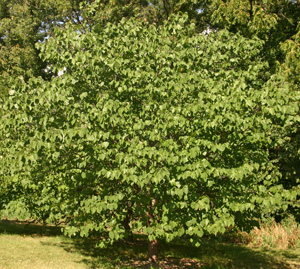
Eastern red bud typically grows 20-30 feet tall with a short trunk (or several trunks in multistemmed individuals) and spreading branches to form a broad flat or rounded crown. Young plants have an upright vase growth habit and will develop an irregular shape if not grown in the open.
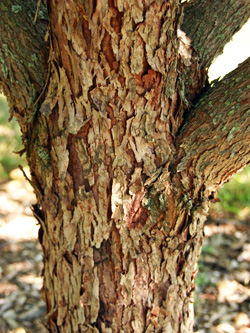
Trees grow quickly when young, then have a medium growth rate. The dark red brown bark has a scaly surface and forms deep fissures to expose the cinnamon-orange interior. On older trees there can be dark purplish patches on the bark, and the trunk may become twisted with age. The slender, zig-zagging stems are dark, almost black, with lighter colored lenticels and tiny, rounded chestnut brown buds on the tips through the winter.
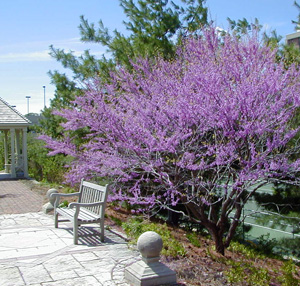
Redbud is one of the first trees to bloom in early spring. The numerous reddish purple buds start opening before the tree leafs out for a very showy display for about a month when most other trees are still bare. Trees may bloom profusely even when very young. It is a cauliflorous tree, producing clusters of 4-8 flowers in fascicles at the axils of the leaves and along the branches and sometimes on the trunk, but most are on two-year-old wood. The flowers range in color from light rosy pink to dark magenta, and there are white forms. Each typical pea-like flower is about ½ inch wide, with 5 petals and 10 stamens. The flowers are visited by many pollinators but only long-tongued bees can reach the nectaries.

The flowers are followed by flat, pea-like pods, although many trees are sterile and produce no fruit. These pods start out green but eventually turn brown when they mature in mid- to late summer. Each of the 2-4 inch long pods contain 4-12 flat, elliptical brown to black kidney-shaped seeds. When numerous, the pods may detract from the appearance of the tree, but heavy fruit crops do not occur every year. The pods can be persistent or fall in early winter. Under ideal conditions it will self-seed but usually not to the point of being problematic.

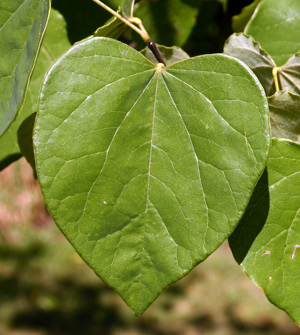
The leaves are a bright green tinged red when they first emerge from the winter buds, changing to dark green above and paler below when fully expanded. The alternate, cordate (heart-shaped) to broadly ovate leaves have smooth margins and prominent veins.
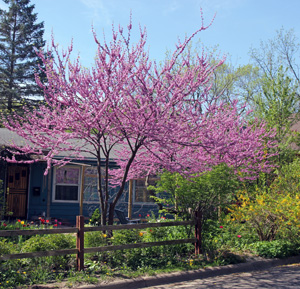
The thin, papery leaves on slender petioles may turn a bright, clear yellow color in the fall in some years but good fall color is unreliable.
Both the species and several cultivars are grown in gardens and parks, in residential and commercial landscapes, or as street trees or foundation plants. It can be used alone as a small specimen or in small groupings. It combines well with other shrubs and perennials in a mixed border and works well as a naturalized planting along a forest edge. As a relatively small tree, it is well suited to smaller properties and as a patio tree.

Although there are many cultivars available, not all are equally hardy. For anyone planting in zone 5 or colder it is best to purchase from local sources as trees from other areas may not be sufficiently cold-hardy. Some cultivars include:
- ‘Ace of Hearts’ is a compact selection (to about 12 feet high) hardy in zones 5-9 with light violet flowers.
- ‘Alba’ has white flowers that bloom a little later than the species.
- ‘Appalachian Red’ has deep red purple buds that open to bright pink flowers.
- ‘Columbus’ or “Columbus Strain’ is a selection collected near Columbus, WI that is hardier than the species, so is a useful seed strain for Midwestern and northern US areas. ‘Wisconsin’ or ‘Wisconsin Strain’ refers to this same selected population
- ‘Covey’ (Lavender Twist™) is a weeping form, with stiff, contorted stems.
- ‘Flame’ has double rose pink flowers and seldom sets fruit. It is more erect than the species.
- ‘Forest Pansy’ has vivid reddish-purple leaves in early spring that changes to dark green on the upper surface later in the season. It tends to bloom later than the species with darker colored, almost purple, flowers. This cultivar received the Royal Horticultural Society’s Award of Garden Merit. Originally found as a seedling in 1947 at Forest Nursery, McMinnville, TN, information on its hardiness is somewhat conflicting.

- ‘Heart of Gold’ has bright yellow leaves.
- ‘Northland Strain’ is a very cold-hardy selection from Minnesota.
- ‘Pinkbud’ has clear pink flowers.
- ‘Royal White’ has white flowers that are larger and earlier-blooming than ‘Alba’.
- ‘Silver Cloud’ has variegated foliage irregularly splotched with white, but green reversions occur that must be removed. It does not flower as heavily as the species.

Eastern redbud can be grown in full sun to partial shade, although the best flowering will be in full sun. Although it is tolerant of clay soil it does best in moist, well-drained deep soil. It can tolerate drought but does better with regular watering. It requires pruning when young to develop a good shape and strong structure.
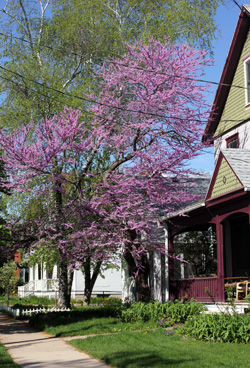
This species does not transplant well because it develops a deep taproot, so it is best to plant young trees. It is important to have the right genetic material as cold hardiness varies considerably. Twig kill and dieback in colder zones is not uncommon. Some other drawbacks are that the wood can be brittle with older trees splitting at crotches and branches breaking off in wind and a heavy snow, and this species tends to be short-lived, especially if stressed. It is tolerant of juglone, so can be grown under black walnut.
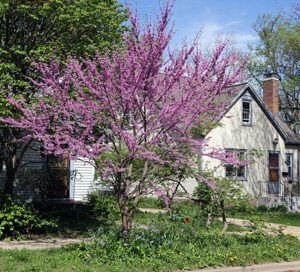
It has few insect pests other than scales and is not favored by deer, but is susceptible to Verticillium wilt (especially in wet sites) and Botryosphaeria canker. The species is easily propagated from seed, but the cultivars must be budded onto seedling rootstock or propagated by summer cuttings. Fresh seed can be sown directly into the field in the fall, but mechanical scarification or hot water immersion followed by moist stratification for 5-8 weeks is required for germination of dried seeds to be planted in outdoor seed beds in late spring.
– Susan Mahr, University of Wisconsin – Madison





 Top Ornamental Crabapples for Wisconsin
Top Ornamental Crabapples for Wisconsin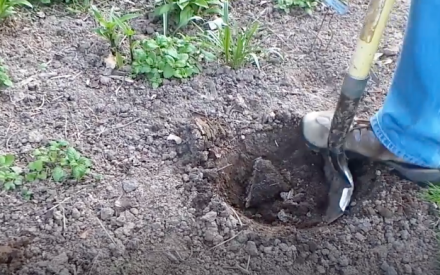 Promoting Urban Forestry: Planting Bareroot Trees in Home Landscapes
Promoting Urban Forestry: Planting Bareroot Trees in Home Landscapes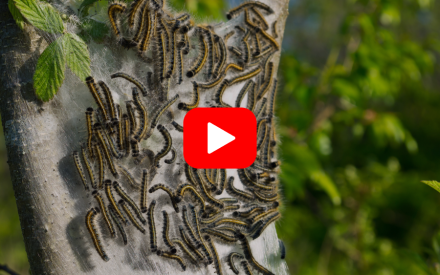 ▶︎ Watch: Torching Tent Caterpillars
▶︎ Watch: Torching Tent Caterpillars ▶︎ Watch: Planning for Fall Planting – Choosing the right trees and shrubs for success
▶︎ Watch: Planning for Fall Planting – Choosing the right trees and shrubs for success


